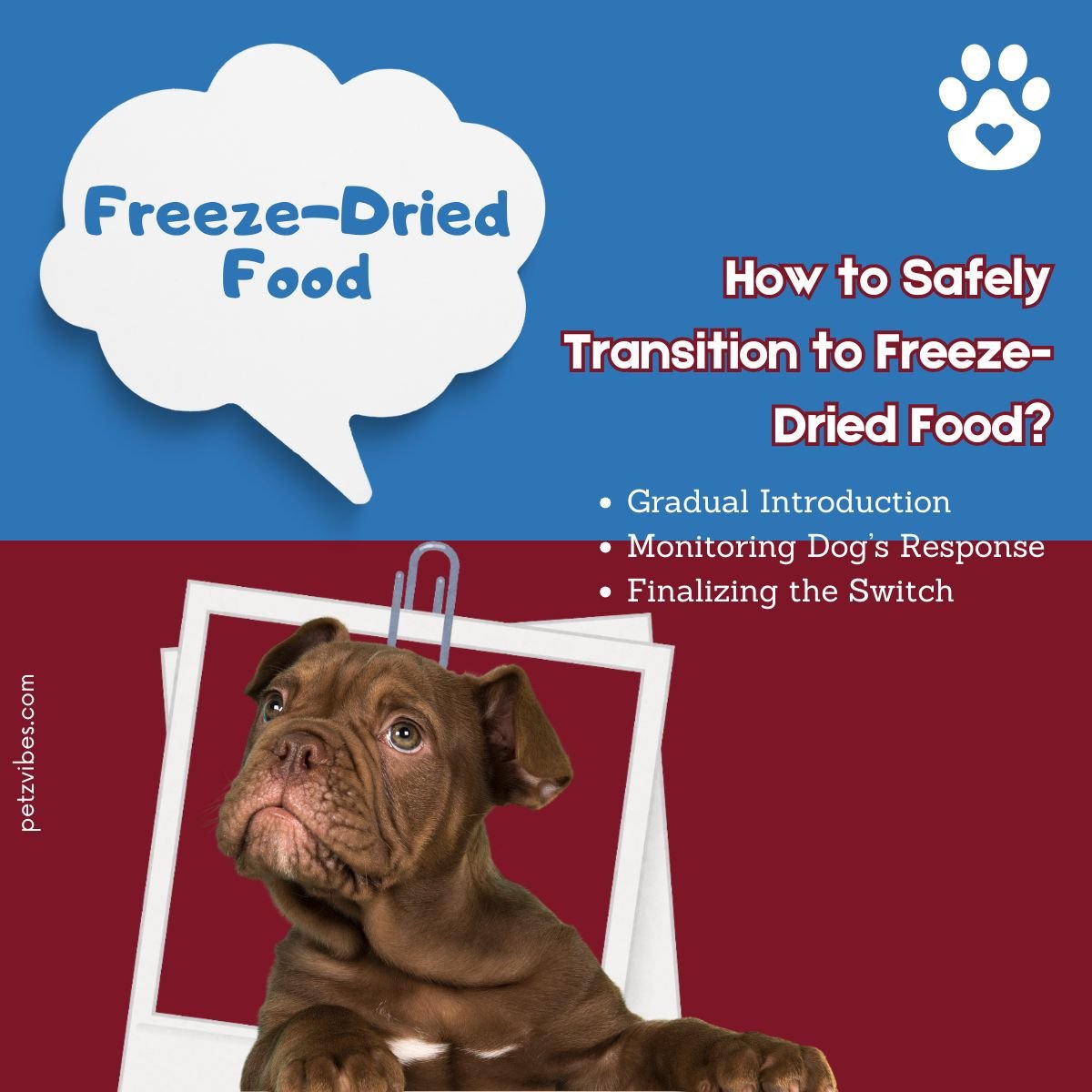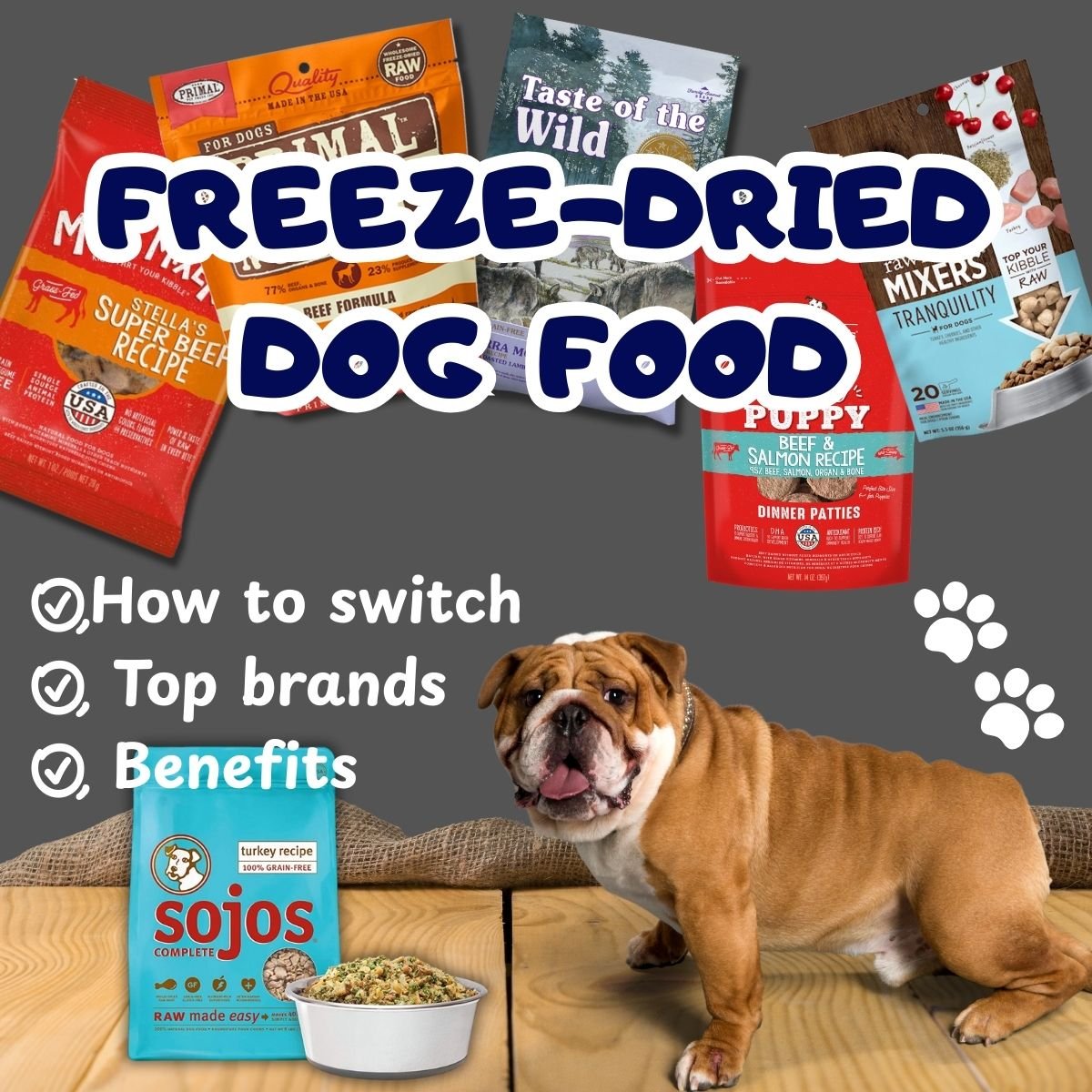Freeze dried dog food is revolutionizing pet nutrition, offering a shelf-stable, nutrient-rich alternative to kibble and raw diets. With the global market projected to reach $525 million by 2026, this minimally processed option is gaining traction among pet owners. With so many options, picking the best diet for your furry companion can be overwhelming. This guide will explore how freeze-drying works, its benefits, top brands, and how to transition your dog safely.
Disclosure: PetzVibes.com is a free online platform that provides valuable content and comparison services. To keep this resource free, we may earn advertising compensation or affiliate marketing commissions from the partners featured in this blog.
🦴 Key Takeaways
✅ Nutrient-Dense: Retains raw food’s benefits without refrigeration.
✅ Convenient: Ideal for travel and storage.
⚠️ Safety First: Choose HPP-treated brands and practice hygiene.
💰 Investment: Higher cost but offsets vet bills from poor nutrition.
🐾 Transition Gradually: Avoid digestive upset.
Understanding Freeze Dried Dog Food
Freeze-dried dog food is made from real meat, vegetables, and grains. The process involves removing moisture while preserving nutrients, resulting in a lightweight, shelf-stable product that retains flavor and freshness. Unlike traditional kibble, freeze-dried dog food skips high-heat processing, keeping more vitamins and minerals intact.
How Freeze-Drying Works
The freeze-drying process involves three key steps:
-
Freezing the food to lock in nutrients.
-
Placing it in a vacuum to remove moisture.
-
Gently heating to eliminate remaining water content.
This method ensures that freeze-dried dog food maintains its original texture, taste, and nutritional value, making it a fantastic alternative to raw or canned food.
🐶Nutritional Benefits of Freeze-Dried Dog Food
Switching to freeze-dried dog food offers several health advantages:
✅ High Nutrient Retention – Essential vitamins and minerals stay intact.
✅ Rich in Protein – Made with real meat for muscle health.
✅ No Fillers or Artificial Additives – Free from unnecessary preservatives.
🦴 Benefits of Freeze Dried Dog Food
There are multiple advantages to opting for freeze-dried dog food, making it a more intelligent choice for your pet.
- Convenience and Shelf Life
One of the most significant benefits of freeze-dried dog food is its convenience. It doesn’t require refrigeration, meaning you can store it easily in your pantry. Upon rehydration, it transforms back into a nutritious meal. Its long shelf-life saves you trips to the store, making it an ideal option for pet owners with busy lifestyles.
- Lightweight and Travel-Friendly
Whether going on a road trip or heading out for a weekend adventure, freeze-dried dog food is incredibly lightweight. This makes packing and feeding your pooch on the go simple and hassle-free. You only need to add water to make a nutritious meal wherever you are.
- Improved Digestion
Many dog owners note that their pets have experienced improved digestion after transitioning to freeze-dried food. This can be attributed to the high-quality ingredients and the absence of harmful additives, which can sometimes lead to stomach issues in dogs. Overall, a diet rich in wholesome ingredients often translates to a happier tummy.
- Variety of Flavors and Options
One of the joys of feeding your dog freeze-dried food is the variety you can choose from. Most brands offer a range of flavors, from beef and chicken to fish and lamb. This lets you discover what your pup loves the most, making mealtime more exciting.
🐶Popular Freeze Dried Dog Food Brands: Detailed Comparison
Choosing the right freeze-dried dog food brand can transform your dog’s health and mealtime excitement. Below, we dive deeper into top brands, including pricing, protein options, and unique benefits.
1. Stella & Chewy’s
Price Range (USD): 21.84–46.54 (5.5 oz to 14 oz bags) 110
Key Features:
-
95% meat, organs, and bone (grass-fed beef, cage-free poultry, wild-caught fish) 7.
-
Pea-free, lentil-free, and potato-free formulas for dogs with sensitivities 1.
-
Organic fruits/vegetables and added probiotics for digestion 7.
-
Versatile serving: Can be fed dry, rehydrated, or as a topper 10.
Popular Products: -
Super Beef Patties ($34.19/14 oz) 1.
-
Absolutely Rabbit Patties ($42.74/14 oz) 4.
Best For: Picky eaters, dogs with allergies, and owners seeking whole-prey nutrition.
2. Instinct Raw Boost
Price Range (USD): 16.99(5.5oz topper)–60 (10 lb kibble + freeze-dried mix) 28.
Key Features:
-
Combines kibble with freeze-dried raw pieces for texture variety 8.
-
Grain-free options with cage-free chicken or grass-fed beef 11.
-
Functional blends: Calming toppers with valerian root and tryptophan 2.
-
High protein (up to 37% crude protein) 8.
Popular Products: -
Raw Boost Mixers Calming Topper ($16.99/5.5 oz) 2.
-
Raw Boost Grain-Free Kibble + Raw ($60/10 lb) 8.
Best For: Dogs transitioning from kibble, small breeds, and pets needing stress support.
3. Primal Pet Foods
Price Range (USD): 25–45 (14 oz bags) 12.
Key Features:
-
Novel proteins like venison and goat for allergy-prone dogs 12.
-
Sustainably sourced ingredients with bone for calcium 6.
-
No artificial additives or fillers 12.
Popular Products: -
Freeze-Dried Nuggets (Venison, $45/14 oz).
Best For: Eco-conscious owners and dogs with protein sensitivities.
4. Taste of the Wild
Price Range (USD): 30–50 (14 oz bags) 12.
Key Features:
-
Grain-free recipes with roasted meats and superfoods 6.
-
Probiotic strains for gut health 12.
-
Affordable compared to other premium brands.
Popular Products: -
Prey Turkey & Trout ($45/14 oz).
Best For: Budget-conscious buyers seeking high-protein, grain-free options.
5. Sojos
Price Range (USD): 20–35 (1 lb bags) 12.
Key Features:
-
Customizable meals: Add water, raw meat, or kibble 12.
-
Minimal processing with freeze-dried base mixes 6.
-
No preservatives or artificial ingredients.
Popular Products: -
Complete Mixes (Lamb, $30/1 lb).
Best For: Owners who want control over ingredient ratios and hydration levels.
Comparison Table
| Brand | Price Range (USD) | Key Feature | Best For |
|---|---|---|---|
| Stella & Chewy’s | 21–46 | 95% meat/organ/bone, organic produce | Picky eaters, allergy-prone dogs |
| Instinct Raw Boost | 17–60 | Kibble + raw mix, calming toppers | Kibble transitions, small breeds |
| Primal Pet Foods | 25–45 | Novel proteins, sustainable sourcing | Eco-conscious owners |
| Taste of the Wild | 30–50 | Grain-free, probiotics | Budget-friendly raw feeding |
| Sojos | 20–35 | Customizable, minimal processing | DIY meal planners |
To remember:
-
Stella & Chewy’s leads in palatability and whole-prey nutrition.
-
Instinct Raw Boost is ideal for gradual transitions from kibble.
-
Primal and Taste of the Wild offer unique proteins for sensitive dogs.
-
Sojos provides flexibility for owners who prefer DIY meals.
💖 Switching to Freeze Dried Dog Food: A Safe Transition Guide

Transitioning your dog to freeze-dried food requires patience and careful monitoring to ensure digestive health and acceptance. Follow these steps for a smooth switch:
1. Gradual Introduction (7–10 Days)
Days 1–3:
-
Mix 25% freeze-dried food with 75% current food.
-
Tip: Rehydrate the freeze-dried portion with warm water (1:1 ratio) to ease digestion and enhance aroma.
Days 4–6:
-
Increase to 50% freeze-dried, 50% current food.
-
Watch for: Stool consistency (should remain firm) and meal enthusiasm.
Days 7–10:
-
Shift to 75% freeze-dried, 25% current food.
-
For sensitive dogs: Extend the transition to 14 days if needed.
Day 11+:
-
Fully transition to 100% freeze-dried food if no issues arise.
2. Monitoring Your Dog’s Response
-
Digestive Health:
-
An ideal stool should be firm and brown. Loose stools may indicate a too-rapid transition.
-
Temporary gas is normal; persistent bloating or diarrhea warrants a vet visit.
-
-
Energy & Appetite:
-
A healthy transition maintains your dog’s energy levels. Lethargy or refusal to eat signals discomfort.
-
-
Hydration:
-
Freeze-dried food absorbs water, so ensure fresh water is always available.
-
If Issues Occur:
-
Pause the transition and revert to the previous ratio for 2–3 days.
-
Consult your vet if problems persist.
3. Finalizing the Switch
-
Hydration is Key: Always rehydrate freeze-dried food unless the brand specifies it can be fed dry (e.g., as a topper).
-
Portion Control: Adjust servings based on your dog’s weight and activity level. Freeze-dried food is calorie-dense, so overfeeding can lead to weight gain.
-
Storage: Reseal bags tightly or transfer to an airtight container to maintain freshness.
4. When to Consult Your Veterinarian
Before transitioning, schedule a check-up if your dog:
-
Has a history of pancreatitis, kidney disease, or food allergies.
-
It is a puppy, senior, or pregnant/nursing.
-
Takes medications affected by dietary changes (e.g., insulin).
Pro Tip: Bring the freeze-dried food’s ingredient list to your vet to review for potential allergens or imbalances.
In summary:
🐾 Transition Slowly: 7–10 days minimizes digestive upset.
💧 Hydrate Thoroughly: Prevents dehydration and aids digestion.
👀 Monitor Closely: Stool, energy, and appetite are critical indicators.
🩺 Vet First: Essential for dogs with health conditions.
Did You Know? Adding a probiotic supplement during the transition can support gut health. Ask your vet for recommendations!
🐕 How to Serve Freeze Dried Dog Food for Optimal Nutrition
Proper preparation and storage of freeze-dried dog food ensure your pet gets maximum benefits from this nutrient-rich diet. Follow these guidelines for best results.
Preparation: Rehydrating for Digestibility
-
Water Ratio:
-
Standard: 1 part food to 2 parts warm water (helps absorption)
-
Adjustable: For softer texture, use more water (up to 1:3 ratio)
-
Pro Tip: Let it sit for 3-5 minutes to fully rehydrate before serving.
-
-
Alternative Serving Methods:
-
As a Topper: Crumble dry over kibble to enhance flavor
-
For Training: Use small dry pieces as high-value treats
-
Puzzle Feeders: Rehydrated food works well in slow-feed bowls
-
Serving Sizes: Customized to Your Dog
| Dog Weight | Daily Amount* |
|---|---|
| 10 lbs | ¼ – ½ cup |
| 30 lbs | ¾ – 1¼ cups |
| 50 lbs | 1½ – 2 cups |
| 70+ lbs | 2½ – 3 cups |
Always check brand-specific guidelines, as calorie content varies
Adjust For:
-
Activity Level: Working dogs may need 10-20% more
-
Age: Puppies often require 3-4 meals daily
-
Health Conditions: Overweight dogs may need measured portions
Storage: Maintaining Freshness
-
Unopened Packages:
-
Store in a cool, dry place (under 75°F)
-
Shelf life: Typically 18-24 months
-
-
After Opening:
-
Best Option: Transfer to an airtight container with an oxygen absorber
-
For Longevity: Refrigerate (extends freshness by 2-3 months)
-
Avoid: Humidity or temperature fluctuations
-
-
Travel Tips:
-
Use vacuum-sealed portions for trips
-
Pack silica gel packets to prevent moisture
-
Key Reminders:
✔ Always provide fresh water alongside meals
✔ Wash bowls after each feeding (rehydrated food spoils faster)
✔ Note expiration dates – nutrients degrade over time
🐶 Freeze Dried Dog Food: Addressing Common Concerns
While freeze-dried dog food offers numerous benefits, responsible pet owners often have significant questions. Here’s a detailed look at the most frequent concerns with evidence-based answers.
1. Safety: Is Freeze-Dried Food Risky?
✅ Pathogen Control:
-
Reputable brands use High Pressure Processing (HPP) or *freeze-drying at -40°F* to eliminate Salmonella/E. coli
-
Look for brands that conduct third-party pathogen testing (e.g., Stella & Chewy’s publishes results)
⚠️ Handling Precautions:
-
Wash hands/utensils after preparation (like handling raw meat)
-
Immunocompromised humans should consider wearing gloves when serving
📊 Safety Data:
A 2022 Journal of Animal Science study found freeze-drying reduces bacterial loads by 99.7% when properly processed.
2. Suitability: Which Dogs Should Avoid It?
🚫 Cases Requiring Vet Consultation:
-
Kidney disease: High protein content may need adjustment
-
Pancreatitis history: Fat levels vary by brand/formula
-
Puppies under 6 months: Requires AAFCO “complete & balanced” labeling
🐩 Best Candidates:
-
Dogs with food sensitivities (single-protein options available)
-
Senior dogs need palatable, nutrient-dense meals
-
Active breeds benefit from high-protein content
Pro Tip: Transition slowly (over 2-4 weeks) for dogs with chronic conditions.
3. Nutrition: Can It Fully Replace Fresh Food?
🔍 Nutritional Comparison:
| Nutrient | Freeze-Dried Retention | Fresh Food | Kibble |
|---|---|---|---|
| Protein Quality | 95-98% | 100% | 70-80% |
| Vitamin C | 90% | 100% | 40% |
| Enzymes | Preserved | Present | Lost |
💡 Balanced Diet Strategies:
-
Rotation Feeding: Alternate with fresh raw or gently cooked foods
-
Supplementation: Add fresh veggies/fruits for fiber diversity
-
Dental Health: Combine with dental chews (freeze-dried, lacks abrasive texture)
Veterinary Consensus:
The American Veterinary Medical Association states freeze-dried diets can be nutritionally complete when properly formulated (source: AVMA.org).
Key Takeaways
✔ Choose HPP-treated brands for maximum safety
✔ Consult your vet before switching dogs with health conditions
✔ Combine with fresh foods for dietary diversity when possible
✔ Store properly to maintain nutritional integrity
🐾 Conclusion: Is Freeze Dried Dog Food Right for Your Pup?
Switching to freeze dried dog food offers a powerful combination of nutrition, convenience, and taste that both dogs and owners love. With benefits like 95% nutrient retention, long shelf life, and digestibility, it’s no wonder more pet parents are choosing this option.
Before You Switch:
✔ Transition gradually (7–14 days) to avoid digestive upset
✔ Hydrate properly—most brands require water for optimal digestion
✔ Consult your vet—especially for puppies, seniors, or dogs with health conditions
✔ Store correctly to maintain freshness and nutrient quality
Final Thought: Freeze-dried food isn’t just a trend—it’s a science-backed upgrade to your dog’s diet. Whether you use it as a full meal, topper, or travel food, it provides raw-like nutrition without the hassle.
Ready to try it? Start with a small bag of a reputable brand (like Stella & Chewy’s or Primal) to see how your dog responds!
FAQ: Freeze Dried Dog Food Explained
1. Is freeze-dried dog food as healthy as fresh raw food?
Yes! Freeze-drying preserves 95% of nutrients, making it comparable to fresh raw—but with a longer shelf life and no refrigeration needed.
2. How long does freeze-dried dog food last after opening?
Typically 1–3 months if stored in an airtight container in a cool, dry place. Some brands recommend refrigeration after opening.
3. Can I feed freeze-dried food dry, or do I need to add water?
You can feed it dry as a treat or topper, but rehydrating (with warm water) is best for digestion and hydration.
4. Is freeze-dried food safe for puppies?
Yes, but only if labeled “complete & balanced for all life stages” (check for AAFCO statement). Puppies may need more frequent meals.
5. Why is freeze-dried food more expensive than kibble?
-
High-quality ingredients (real meat, organs, veggies)
-
Specialized processing (freeze-drying retains nutrients)
-
No fillers (corn, wheat, soy)
6. Can dogs with allergies eat freeze-dried food?
Yes! Many brands offer limited-ingredient or novel protein options (like venison or duck) for sensitive dogs.
7. How do I transition my dog to freeze-dried food?
-
Days 1–3: 25% freeze-dried + 75% old food
-
Days 4–6: 50/50 mix
-
Days 7–10: 75% freeze-dried + 25% old food
-
Day 11+: 100% freeze-dried (if no digestive issues)
8. Can freeze-dried food replace kibble completely?
Absolutely! Many brands meet AAFCO standards for complete nutrition. However, some owners mix it with kibble or fresh food for variety.






